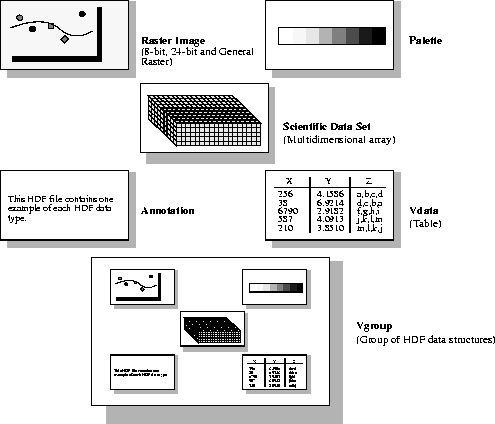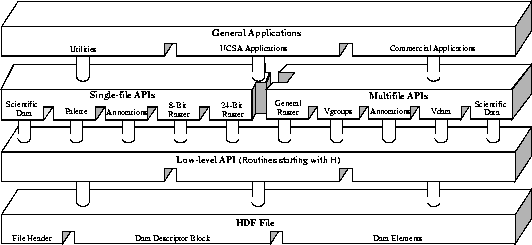[Top] [Prev] [Next]
1.2 What is HDF?
The Hierarchical Data Format, or HDF, is a multiobject file format for sharing scientific data in a distributed environment. HDF was created at the National Center for Supercomputing Applications to serve the needs of diverse groups of scientists working on projects in various fields. HDF was designed to address many requirements for storing scientific data, including:
In this document, the term HDF data structures will be used to describe the primary constructs HDF provides to store data. These constructs include raster image, palette, scientific data set, annotation, vdata, and vgroup. They are illustrated in Figure 1a on page 2. Note that the construct vgroup is designed for the purpose of grouping HDF data structures.
HDF files are self-describing. The term "self-description" means that, for each HDF data structure in a file, there is comprehensive information about the data and its location in the file. This information is often referred to as metadata. Also, many types of data can be included within an HDF file. For example, it is possible to store symbolic, numerical and graphical data within an HDF file by using appropriate HDF data structures.
FIGURE 1a - HDF Data Structures

HDF can be viewed as several interactive levels. At its lowest level, HDF is a physical file format for storing scientific data. At its highest level, HDF is a collection of utilities and applications for manipulating, viewing, and analyzing data stored in HDF files. Between these levels, HDF is a software library that provides high-level and low-level programming interfaces. It also includes supporting software that make it easy to store, retrieve, visualize, analyze, and manage data in HDF files. See Figure 1b on page 3 for an illustration of the interface levels.
The basic interface layer, or the low-level API, is reserved for software developers. It was designed for direct file I/O of data streams, error handling, memory management, and physical storage. It is a software toolkit for experienced HDF programmers who wish to make HDF do something more than what is currently available through the higher-level interfaces. Low-level routines are available only in C.
The HDF application programming interfaces, or APIs, include several independent sets of routines, with each set specifically designed to simplify the process of storing and accessing one type of data. These interfaces are represented in Figure 1b as the second layer from the top. Although each interface requires programming, all the low-level details can be ignored. In most cases, all one must do is make the correct function call at the correct time, and the interface will take care of the rest. Most HDF interface routines are available in both FORTRAN-77 and C. A complete list of the high-level interfaces is provided in Section 1.4 on page 4.
FIGURE 1b - Three Levels of Interaction with the HDF File

On the highest level, general applications, HDF includes various command-line utilities for managing and viewing HDF files, several NCSA applications that support data visualization and analysis, and a variety of third-party applications. The HDF utilities are included in the NCSA HDF distribution.
Source code and documentation for the HDF libraries, as well as binaries for supported platforms, is freely available but subject to the restrictions listed with the copyright notice at the beginning of this guide. This material is available via NCSA's anonymous FTP server ftp.ncsa.uiuc.edu, in the directory /HDF/. (The HDF FTP server at http://hdf.ncsa.uiuc.edu mirrors this material in the directory /pub/dist/HDF/.) Applications supported by NCSA, as well as applications contributed by members of the worldwide HDF user community, are available on these servers.
[Top] [Prev] [Next]
hdfhelp@ncsa.uiuc.edu
HDF User's Guide - 07/21/98, NCSA HDF
Development Group.


